Feature Interview with Mike Dutton
January, 2021
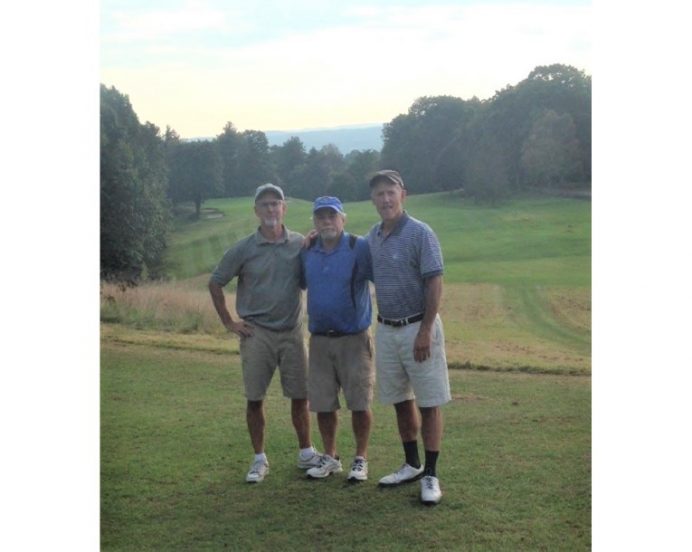
Where there is a great 9 holer, like Hooper Golf Course in New Hampshire, there is a Dutton! Mike is on the right and his brother Jeff is on the left.
1. How did you become interested in 9-hole courses?
I learned to play golf at about the age of 10 when my Dad took me out and would only let me use a 5-iron for all shots around the course until I got near a green. He was a 27-year officer in the Navy and served on submarines. We lived in the Groton, CT area a number of times as he was stationed at the Naval Submarine Base New London more than once throughout his career. The base had a 9-hole course there and the story went that even though the land for military operations at the base was at a premium, the course was necessary not only for its recreational function but primarily as an emergency airfield in the event of a hostile attack. This is the course that I grew up playing, getting dropped off for non-stop rounds on weekends and eventually working there as a starter for my first job in the golf industry. So I memorized that course and even had the second hole-in-one of my career on the 9th hole – a blind shot at the time as the tee has now been moved to prevent the 9th from crossing the 1st hole.
Playing on the Ledyard HS golf team, we played 9-hole matches (usually at 18-hole courses), so I eventually was exposed to 18-hole courses and found them to be useful. But then there were extended summer visits to the grandparents in upstate New York, where the closest course to their farm was a 9-holer named Barker Brook in Oriskany Falls. Barker Brook is, unfortunately, now an 18-hole layout, but in the summers of my youth it was another course where I could get dropped off and play as many rounds as possible before it was time to get picked up.
Jump ahead to 1991 when I am hired as the assistant basketball coach at Vassar College in Poughkeepsie, NY where I would stay for 17 years, 14 of them as the head coach. I was certainly chuffed to find that the college had its own delightful 9-hole course, directly on campus where students, faculty and staff received a substantially discounted green fee…of .50! Though middle-aged, it wasn’t long until, coining a phrase from local hero Lawrence Peter Berra, I was deja vuing all over again.
Vassar GC turned out to be the pivotal course that fueled my adult obsession with 9-hole golf courses. I started tracking my scores, GIR’s, putts, scoring averages by hole, birdies, penalty stokes, comparing yearly averages to the last, you name it. Over my 17 years playing in my backyard (my office window looked out on the 9th fairway) the easiest hole was #2 and the toughest was #9. Par was 34 and the course yardage was padded at 2,790 yards.
Below is my scorecard from Wednesday, May 29, 1996. I was the 77th green fee of the day (probably playing after work). It is interesting to note that 25 years ago the VASSAR GOLF COURSE was “A Private Daily Fee Golf Course” where “…impeding other players will result in a request to leave, upon refund of fees.” The card also acted as my receipt for payment, where if you look closely just ahead of the 8th tee you can see “0.50 CA” imprinted on the scorecard after being inserted into the cash register.
 |
 |
My lifetime eclectic score reveals 4 eagles, yet no aces: 3, 2, 2, 3, 2, 2, 2, 3, 2 = 21 (-13)
Vassar GC is still in full bloom today, run by one of the most gracious PGA pros in our business, Rhett Myers, and offers a fun game on firm turf in a beautiful campus setting. There are no tee times, so just show up and if you do, be sure to say “Hi” to Rhett for me.
2. That ‘impeding other players’ line on the scorecard is priceless! Moving on, what advantages do 9-hole courses hold over 18 hole ones? Any disadvantages?
The mainstream argument I constantly hear these days for 9-hole courses over 18-holers centers on the concept of the busyness of people’s lives – the lack of time in their day to commit to 18 holes of golf. While this may be true about people’s lifestyles, it is not the most valid argument for 9-hole courses. Why? Because I have yet to find an 18-hole course that requires a player to play all 18 holes of the course. Anyone can go play as many or as few of the holes at an 18-hole layout as they wish.
Fundamentally, 9-hole courses are simply different from 18-holers because they are usually intimate, relaxed, flexible, and familiar. And often they reek of what Englishman Greg McKeown writes about in “Essentialism – The Disciplined Pursuit of Less”, the concept of “less, but better”. Case in point in New England where a good number of quality 9-hole tracks have been turned into mediocre 18-holers.
The biggest disadvantage for 9-holers is the lack of opportunity for hole variety that a big course, simply by its nature, possesses. But if the golfer’s 9-hole challenge is creatively laid out, pleases his eye and the feeling he gets from playing is one of excitement, then the variety of holes concern becomes moot.
The leisurely 9-holer offers the flexibility of a 9 or 18 hole option at the two-hour point of the golf day. Play again or go home? The golfer’s course familiarity/comfort level with his swing/knowledge of the day’s course set-up, all give insight when playing the immediate second loop and cannot be matched at the bigger course playing each new hole. The golfer gets both the curiosity of the unknown (1st loop) combined with the comfort of the now known (2nd loop) in the same day’s golf experience. The immediacy of a second 9-hole loop v. the protracted experience of playing a second 18 after lunch is just not as intense.
Replaying a nine for a total of 18 holes v. a single 18-hole round are two quite different golf experiences in my mind. Both provide value, but sometimes we want familiarity. Plus the chance to go a third or fourth time? The golfer can challenge himself to do better multiple times and I would argue it is more focal to do so in 9-hole increments. And a supportive view that I like from Lorne Rubenstein, “To some, nine holes might feel limited. But the compression can feel expansive. One might see and feel more in a smaller than larger space.”
3. Talk about how you go about playing new 9-hole courses.
Given the lack of big money or time commitment, I am always up for trying a new 9-hole course and there is a decision matrix which usually goes something like this:
Decision: #1 Have I played this course before? –>No–>Let’s go play!
#2 Was it a quality course/fun to play? –>No–>Leave now!
–>Yes–>Let’s go again!
#3 Did I lose multiple strokes due to lack of local knowledge?
–> Yes (yes is always the answer here)–>Let’s play again, I can do better!
#4 Would I ever want to return to play this course again?
–>Yes–>Added to personal favorite list.
–>No–>Dutton golf purgatory.
#5 Is it too dark to play again?
4. You now live outside of Portland, Maine. How has living in the Northeast shaped your fascination?
New England has the highest density of 9-hole courses of anywhere in the country. It also has an above average percentage of regulation 9-hole courses relative to other areas of the US, second only to the Upper Midwest. Small New England towns have been around longer, with many named after a city, town or area in England. Older small town golf courses were modeled after those found in the UK with many of them being laid out by Scotsmen. Land and finances often dictated that a 9-hole course was what could be afforded/built in small town New England, similar to how village golf courses were built and still exist today all over the UK and Ireland. So in furtherance, as a historian, these similarities have drawn me yearly ‘across the pond’ to seek the origins of New England golf found in the UK.
Regional Density of 9-hole courses:
1. New England (CT, MA, ME, NH, RI, VT)
267 courses in 71,992 square miles = 270 square miles/course
2. Mid Atlantic (DE, MD, NJ, NY, PA)
400 courses in 124,228 square miles = 311 sm/c
3. Upper Midwest (IA, KS, NB, ND, SD)
681 courses in 363,720 square miles = 534 sm/c
5. Let’s cover some of the more arcane facts about 9-holers in the US.
Firstly I must give credit where it is due in regard to most researchable information on 9-hole golf courses in the US. Most of the Golf Club Atlas membership I’m sure is familiar with the National Golf Foundation (NGF) located in Jupiter, FL. The primary mission of the NGF is to supply data to the various stakeholders in the business of US golf. They do a wonderful job and are a major resource in my research.
In regard to 9-hole courses, I review their information and try to take it a step further. For instance, the NGF publishes a yearly report, “Golf Facilities in the U.S.”, that counts all of the golf courses and golf facilities in the country. Great stuff, but the way this information is compiled does not give a complete picture of 9-hole courses. Their 9-hole courses are simply courses with 9 holes and their publicly reported data does not break “9-hole courses” into its subcategories which are: 1) Regulation courses, 2) Par-3 courses, 3) Executive courses, plus 4) Courses with neither 9 nor 18 holes. In my New England state-by-state analysis of 9-hole courses, I delineate the nines into these subcategories. And for the record, the information that I will share on New England courses and golf holes will focus on those courses that I consider REGULATION 9-hole courses.
Also, please keep in mind that statistics regarding courses are constantly in flux, especially after the year we’ve seen in 2020. Courses close, new courses open, old courses reopen, courses add or subtract nine holes, some courses need to be tracked down when they have no web site or aren’t a member of their respective state golf association, is a driving range with a pitch and putt course a golf course or a golf facility? Some moving targets to say the least, and each affects state totals and ratios. At some point you just have to stop and take a snapshot. So please consider that all of these numbers are the best that I can come up with at a point in time after the most careful analysis and reflection. OK, so here we go…
Fact #1
There are seven states that have more 9-hole courses than 18-hole courses:
| State | 9’s | Total Courses | % that are 9 holers |
| 1. North Dakota | 89 | 117 | 76% |
| 2. Alaska | 15 | 23 | 65% |
| 3. Iowa | 250 | 401 | 62% |
| 4. South Dakota | 79 | 127 | 62% |
| 5. Kansas | 139 | 250 | 56% |
| 6. Nebraska | 124 | 232 | 53% |
| 7. Maine | 69 | 133 | 52% |
The bottom eight states in this metric are primarily found in the southern parts of the US. They possess the following general set of attributes – newer courses than the northeast, more land, less density of population and better weather for year round golf – but the two most influential attributes are 1) vacation destinations and 2) a large volume of retirees and retirement communities. These factors, combined with the good old US mantra ‘more is better’, have led to the building of 18-hole tracks in these states.
| State | 9’s | Total Courses | % that are 9 holers |
| 43. Georgia | 49 | 420 | 12% |
| 44. Hawaii | 10 | 88 | 11% |
| 45. Nevada | 12 | 112 | 11% |
| 46. Arizona | 37 | 378 | 10% |
| 47. Delaware | 4 | 45 | 9% |
| 48. North Carolina | 49 | 557 | 9% |
| 49. Florida | 94 | 1306 | 7% |
| 50. South Carolina | 26 | 366 | 7% |
The current US average of 9-holers to total courses is about 23%. Just a few years ago, this number was closer to 25%, and until 1974 there were more 9-hole than 18- hole courses in the US.
Fact #2
If we look simply at the number of 9-hole courses per state we have a surprise leader. Who would have guessed Iowa (and by a large margin)?
The top six:
| 1. Iowa | 250 |
| 2. Texas | 202 |
| 3. New York | 200 |
| 4. California | 187 |
| 5. Illinois | 180 |
| 6. Minnesota | 163 |
The bottom six:
| 45. Utah | 20 |
| 46. Vermont | 20 |
| 47. Alaska | 15 |
| 48. Nevada | 12 |
| 49. Hawaii | 10 |
| 50. Delaware | 4 |
The current average for 9 hole courses per state is about 77 courses.
6. I had no idea more 9-holers existed in the United States than 18 holers as recently as 1974. What state in the US has the most per capita? Fewest per capita?
In regard to per capita, the top four states (measured in 9-hole courses/1M people) are:
| 1. North Dakota | 117 |
| 2. South Dakota | 87 |
| 3. Iowa | 79 |
| 4. Nebraska | 64 |
States in the Upper Midwest have a strong number of 9-hole courses, lower populations but moderately large land areas. It corners the market in terms of per capita measurements.
The bottom four states are:
| 47. Florida | 4.3 |
| 48. Delaware | 4.1 |
| 49. Maryland | 3.9 |
| 50. Nevada | 3.8 |
The current US per capita average of 9-hole courses is about 11.8 courses/1M people.
7. Is any state either high or low in both per capita and per square mile rankings?
Nevada is the only state that answers the question as it is low in both per capita and per square mile for 9-hole courses. It is punished with only 12 9-hole courses in a state with over 3M people and more than 100k square miles of area.
Most 9-hole courses per square mile (measured in square miles/course…so like a golf scorecard, the lower the number the better):
| 1. Rhode Island | 74 |
| 2. Mass. | 90 |
| 3. Connecticut | 115 |
| 4. New Jersey | 177 |
The bottom four (with Alaska easily being the lowest with only 15 niners for all its massive land):
| 47. Utah | 4,245 |
| 48. New Mexico | 5,790 |
| 49. Nevada | 9,213 |
| 50. Alaska | 44,218 |
The current US average is about 981 square miles per 9-hole course. Removing Alaska, the average dips to about 812 square miles per 9-hole course.
8. Drill down to what you can tell us about 9-hole courses in New England.
Statistics as reported by the National Golf Foundation in Golf Facilities in the U.S. – 2019 Edition:
| State | Total Courses | 9 Hole Courses of Any Type |
| Connecticut | 193 | 48 |
| Maine | 138 | 73 |
| Massachusetts | 382 | 117 |
| New Hampshire | 112 | 38 |
| Rhode Island | 59 | 21 |
| Vermont | 71 | 20 |
| Total in New England | 955 | 317 |
New England 9-hole course statistics updated by me as of October 2020, sorted by percentage of regulation 9-hole courses:
| State | Total Courses | Regulation 9’s (Private) | % of 9 holers | Par 3 | Exec | Non-9/18 |
| 1. Maine | 134 | 67 (4) | 50% | 4 | 1 | – |
| 2. Mass. | 381 | 103 (31) | 27% | 12 | 11 | 3 |
| 3. New Hampshire | 111 | 27 (3) | 24% | 8 | 3 | – |
| 4. Rhode Island | 60 | 14 (4) | 23% | 7 | – | 1 |
| 5. Vermont | 71 | 16 (1) | 23% | 5 | – | 1 |
| 6. Conn. | 193 | 39 (16) | 20% | 3 | 5 | – |
| Totals | 950 | 266 (59 or 22%) | 28% | 39 | 20 | 5 |
9. What other fun facts can you offer?
Maine has the most 9 holers on islands, per below:
New England Island 9-Holers:
MAINE
Causeway Club
Frye Island
Great Chebeague
Mt. Kineo (virtually)
North Haven
Tarratine
MASSACHUSETTS
Edgartown
Mink Meadows
Royal & Ancient Chappaquiddick Links (executive course)
Siasconset
Also, 9 holers sometimes have names that conjure up names of other, (slightly!) more famous courses:
Famous Names/Top 100 Courses in the US – Golf Magazine:
Pine Valley, Pelham, NH/#1 Pine Valley – George Crump/H.S. Colt 1918
Marion, Marion, MA – George C. Thomas/#8 Merion (East) – Hugh Wilson 1912
Oak Hill, Meredith, NH/#40 Oak Hill (East) – Donald Ross 1921
Cherry Hill, N Amherst, MA/#100 Cherry Hills – William S. Flynn 1923
Highland Links, N Truro, MA/ Highlands Links – Stanley Thompson 1935
10. Talk about the New England titans of Design and their best 9-holers.
On the top of my list is Wayne Stiles who created courses around the country from 1916 until his death in 1953. He worked as a solo architect both prior to and after his partnership with John Van Kleek which lasted from 1924-1929. By my count, 16 9-hole designs of his (or theirs) remain in existence today in four of the New England states. His best courses include Hooper (NH), North Haven (ME) and Nehoiden (MA).
A close second in existing 9-holers in New England is Alex Findlay with 15 (possibly 16) according to records, with these being present in three states. Findlay, a Scotsman, hit the golf ground earlier than Stiles, but a number of his designs are NLE and many of his remaining courses have been updated by others. Findlay’s best remaining 9-hole courses include Megunticook and Grindstone Neck (ME) and Siasconset and Northfield (MA). While it is not well known, there are reports that Findlay laid down a 9-hole track at Cape Arundel prior to Walter Travis taking the place up a few notches.
When people think of New England golf, one of the obvious titans for most is Donald Ross, but surprisingly I find only seven (and one is suspect) remaining 9-hole Ross courses in New England. Similarly with Stiles and Findlay, a good number of Ross’ original 9-holers have been turned into modern 18-hole tracks. The Donald’s best remaining 9’s all reside in Massachusetts: Whitinsville, Cohasse and Greenock.
The last titan to mention here is Geoffrey Cornish. A titan by volume and a gentleman to all, Cornish has probably had his hand on more New England golf courses than any architect, past or present. Not so hard to do as he lived in Amherst, MA which is close to the geographic center of the region. Cornish has 11 9-hole courses with his name on them and none of them stand out. What does stand out with Mr. Cornish’s work with 9-hole courses is the list of courses by great architects where he added the second nine (thus negating Miss New England of some of her 9-hole beauty). To highlight a few:
- Brunswick (ME) (Stiles)
- Warwick (RI) (Ross)
- Bath (ME) (Stiles)
- Duxbury Yacht Club (MA) (Stiles & Van Kleek)
- Tekoa (MA) (Ross)
- St. Johnsbury (VT) (Willie Park, Jr)
- Wahconah (MA) (Stiles)
- Wentworth by the Sea (NH) (Ross)
11. Lay out the best New England 9-holer you have ever seen, borrowing only one hole per course and remaining faithful to the hole number.
That isn’t easy but my card based on the 9 holes below would read:
– – – > Par 35 / 3,097 Yards Course Rating 35.7 Slope 122 < – – –
#1 Hooper GC, Walpole, NH Par 5 456 yards
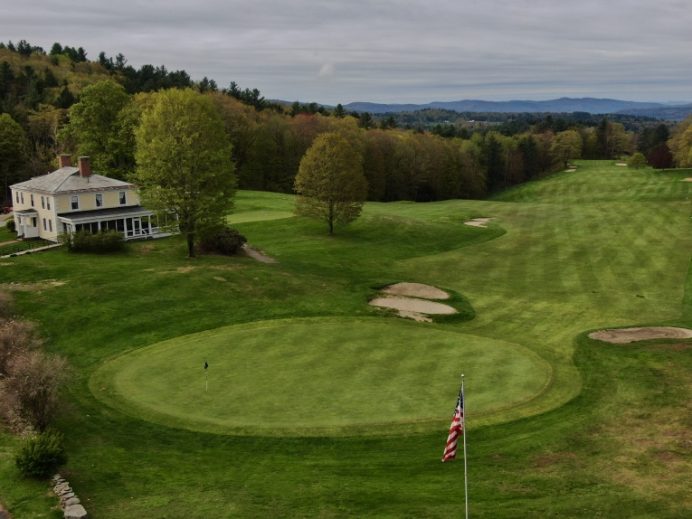
Looking down the Home hole at Hooper at the reachable par 5 1st hole along the left.
#2 Dublin Lake Club, Dublin, NH Par 4 397 yards
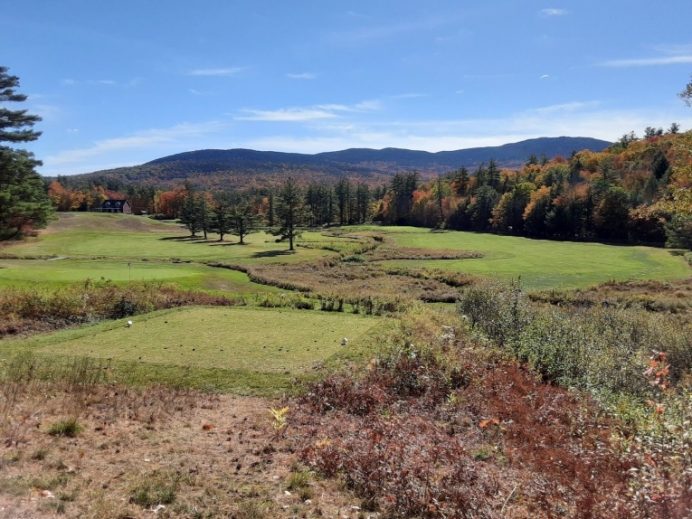
The 2nd at Dublin Lake Club plays out to the right of the stream, 1st green is on the left.
#3 Grindstone Neck GC, Winter Harbor, ME Par 4 317 yards
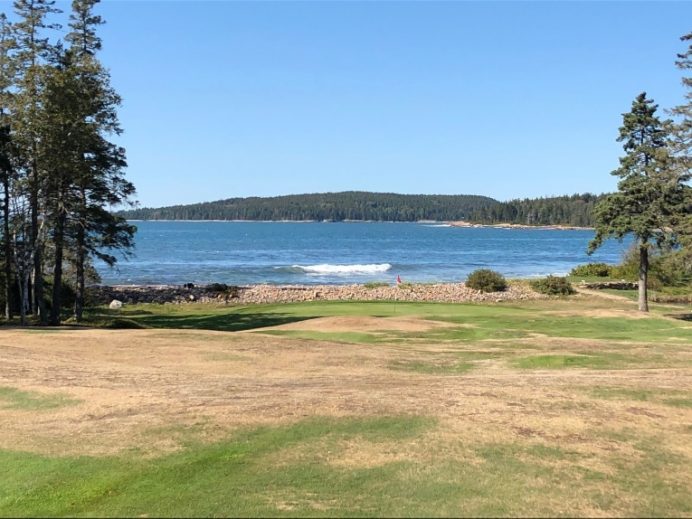
Approach to #3 Halibut Hole, the best shot value at Grindstone where the Alex Findlay routing affords an ocean view on every hole.
#4 Milton-Hoosic Club, Canton, MA Par 4 349 yards
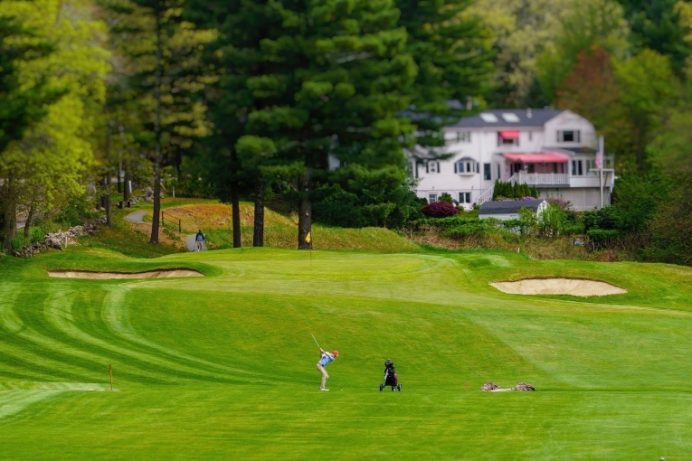
Get as close as you can to the ditch off the tee because you need a precise approach to avoid 3-putting the 4th at Milton-Hoosic.
#5 Greenock CC, Lee, MA Par 4 444 yards – #5 at Greenock is the former opening hole, and all I can say is, thank god it is downhill.
#6 North Haven GC, North Haven Island, ME Par 3 137 yards
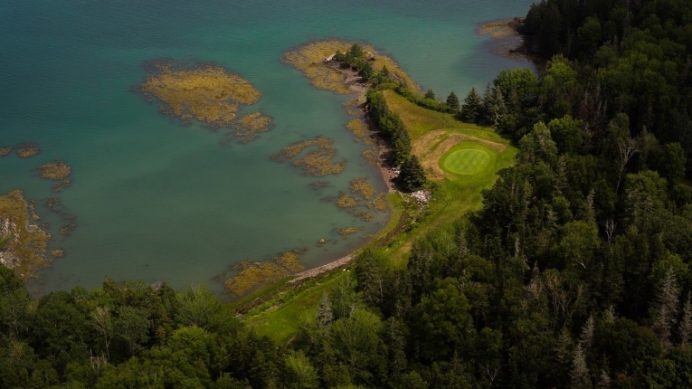
On your 2nd loop at North Haven find the secret tee in the trees to the left for a 172 yard shot over Waterman Cove.
#7 Northampton CC, Leeds, MA Par 3 239 yards – Fun, heroic, elevated tee shot with Biarritz feature before the green and a gallery usually watching from the clubhouse deck.
#8 Castine GC, Castine, ME Par 4 312 yards – The narrowing downhill 8th at Castine plays to a classic Willie Park Jr green. It demands thought from the golfer as he could grab any one of ~5 clubs off the tee.
#9 Whitinsville GC, Whitinsville, MA Par 4 446 yards
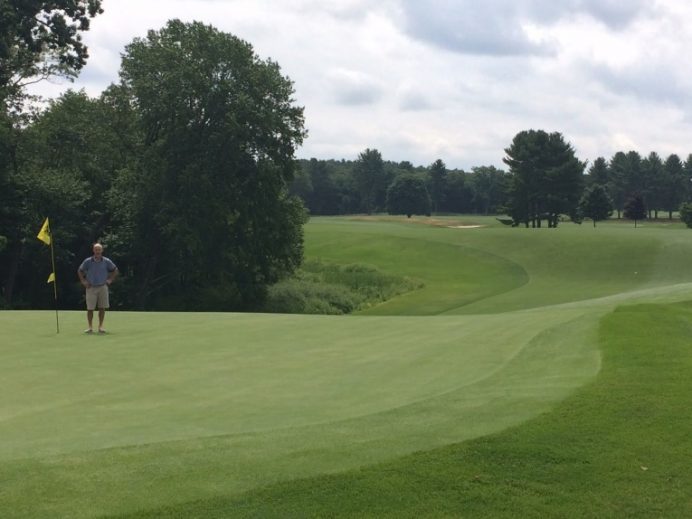
The most celebrated hole on a 9-hole course in New England, Whitinsville’s elevated 9th green looking back to its plateau fairway landing area, where a great tee shot trundles down into the valley.
12. Please describe three of the most unusual holes you have encountered that didn’t make your Dream Course above.
Sebasco Harbor Resort, Sebasco Estates, ME #2 “3 Shelves” Par 3/145 yards: A picturesque shot over a harbor inlet of the Atlantic to a bunkerless green that looks inviting…until your arrival, where one finds three of the skinniest green shelves on the planet. The last time the Dutton Brothers competed at Sebasco, our group scores on #2 for two loops = 8, 3, 8, 8, 6, 6 for a total of +21 over par (pin was on the hardest shelf).
Nehoiden GC, Wellesley, MA #6 “Sunken Treasure” Par 4/369 yards: You see the 6th green as you drive from the college around to the first tee and think, “Hmm…that green sure is small, and wow that hill is really steep leading down to it and boy it’s damn close to the road.” No one, I mean no one, playing Nehoiden for the first time would hit their approach into this green without first walking ahead to get an idea what to do with this shot. Hit it and hope at it’s most fun.
Bellows Falls CC, Bellows Falls, VT #2 “Crater” Par 5/528 yards: Is it man made or natural?, that is the question. The first at Bellows Falls is out and the second is parallel, straight back. Even I knew to go take a peek in the big hole next to the clubhouse before teeing off on #1. The green site is deep, way down there, with conical sides of rough that can hold rather than funnel your ball. And the green at the bottom is not flat!
Honorable Mention:
Scituate CC, Scituate, MA #2 “Langford & Moreau in New England” Par 3/165 yards
Great Chebeague GC, Great Chebeague Island, ME #7 “Stone Wharf” Par 3/104 yards
13. Please talk about three ‘under the radar’ 9-holers in New England that would put a smile on anyone’s face.
Challenging question, as there are so many of these! But how about we go with accessible courses, off the beaten path, from three different states…
Mountain View CC, Greensboro, VT Par 35/2,927 yards 1898: 19th century cow pasture turned golf gem. Elevation changes. Views to Mount Mansfield and of Caspian Lake. Welcoming, earnest and wanting to please. Try to make a par at the downhill 144 yard #3 with its fall away green. Golf in the (Northeast) Kingdom as Michael Murphy might say. World-class suds at Hill Farmstead Brewery, 3.9 miles away.
Wawenock GC, Walpole, ME Par 35/3,032 yards 1926: Stiles & Van Kleek near the seacoast, no ocean views, but solid golf with holes that are properly laid on the land. Great opening elevated tee shot. Toughest test, the rising dogleg 2nd at 418 yards from the tips. Best shot value, finding the green on the short par 4 6th. World-class green complex at the uphill par 3 8th. Bonus feature = post-round lobster rolls.
Profile Club, Franconia, NH Par 35/2,905 yards 1897: The Granite State’s Old Man of the Mountain crumbled in 2003, but his namesake golf course less than five miles away welcomes visitors in both the spring and the fall. A generational summer retreat where ‘relaxed’ and ‘familial’ are the terms to describe your round at the Profile Club. Tip: Aim at the chimney of the 140-year-old farmhouse on your approach to the wonderfully canted 368-yard 4th. Scenic, majestic and natural – this Arthur Fenn design is a fun track in a quintessential New England mountain setting.
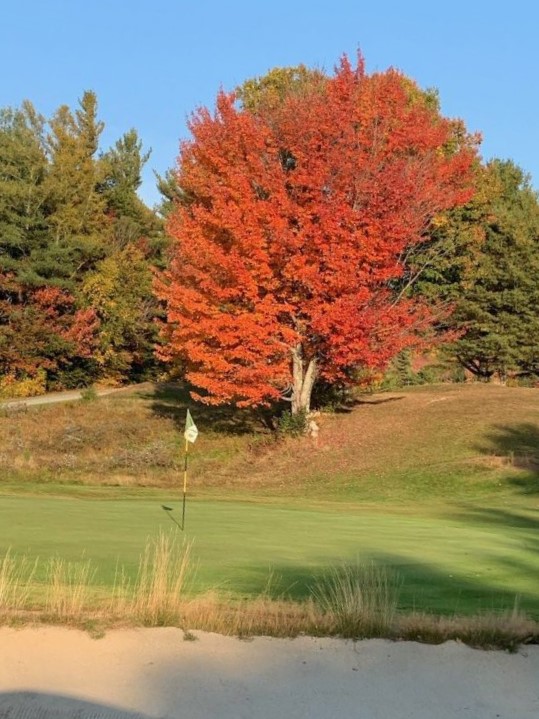
Bump and run is the shot into the 4th green at the Profile Club.
14. For those interested in immersing themselves in 9-holers, please map out a neat three day trip for them in the Northeast.
A standard 3-day trip would include six 9-holers. And unless logistically stupid, you schedule the second course of the day as the better of the daily duo in hope that you will want to play it multiple times. Another key factor is where to eat lunch between visiting the two courses, usually it is not at a golf course. A third factor is the craft beer brewery after the second nine. New England is prime for all three: a plethora of 9-hole golf courses, local flavor lunch purveyors and tasty micro breweries. So pick a state and I will give you an itinerary.
Okay, let’s go with Connecticut…
Day #1
Sharon CC, Sharon, CT Par 36/2,994 yards 1895: Out of the way club set on a big piece of land. The grand view from the 3rd sneaks up on you out of nowhere – expansive rolling hills and glorious farm country. Worthy, interesting green complexes at #4, #6 and #7.
Lunch (2 choices today):
When Pigs Fly South, Sharon, CT (BBQ) – Closed Mondays
Black Rabbit, Lakeville, CT (Bar & grill) – Closed Tuesdays – sit outside
Hotchkiss School GC, Lakeville, CT Par 35/3,080 yards 1926: Seth Raynor course routed around the school where Charles Banks taught. Best 9-hole course in the state of Connecticut. Stunning Raynor greens accessible to the public. I do wish course conditioning was commensurate with the reputation of this first-class school.
Lodging: Interlaken Inn, Lakeville, CT – On the Hotchkiss School campus, a short par 5 away from Seth’s 1st tee. Stay here as a central base for the trip or try the other suggestions at the end of each day if you like to move around.
Day #2
Canaan CC, Canaan, CT Par 35/2,835 yards 1931: Every trip needs at least one course on the other side of the tracks, and CCC literally lies across railroad tracks. Best hole is #6, #8 is the most difficult (though not shown on the card, the tee can be lengthened to 210 yards for this already stout par 3), too bad the maintenance building is the view on its horizon.
Lunch: Roma’s Pizza, Canaan, CT (Pizza or grinders to go + get some beer at Great Falls Brewing Company next door in the old train station)
Norfolk CC, Norfolk, CT Par 36/2,805 1912: Is it a Tillinghast? Go see it and you can decide. Fun course with elevation changes where local knowledge wins the day. Play more than once and still your score might not go down. Well-routed with uphills covered by the par 5’s.
Brewery: Norbrook Farm Brewery, Colebrook, CT – 3.9 miles from NCC
Lodging: Blackberry River Inn, Norfolk, CT – charming 1700’s inn on a beautiful site.
Day #3
Washington Club, Washington, CT Par 35/2,928 yards 1889: Perfect setting on the grounds of The Frederick Gunn School. Get ready for elevated tees, hit down to fairways and then back up to the greens. Well-conditioned course.
Lunch (3 choices today):
The Pantry, Washington Depot (Homemade healthy)
The White Horse, New Preston (Quality pub)
Clamp’s, less than a mile down Rte. 202 from The White Horse (Roadside burgers)
Lake Waramaug CC, New Preston, CT Par 35/3,128 yards 1903: Clubhouse is beautifully situated on the top of a ridge with views of Lake Waramaug. Toughest hole is #2, #4 plays down to the water and like some old courses in the UK, the tee shot on #8 is played over the 7th green.
Brewery: Kent Falls Brewing Co., Kent, CT – As the crow flies, a mere 474 yard par 5 from the 6th green at LWCC, on a working farm.
Lodging: Litchfield Inn, Litchfield, CT – updated inn set in the hills just out of town.
Bonus course: Litchfield CC Par 35/2,820 yards 1917: Just 2.7 miles from the inn – assuredly, I would sneak over at dusk for a few holes. You will certainly remember the Bantam River as it meanders through the course, in play on six of Litchfield’s holes.
Day #4 (Bonus or Alternate day)
Millbrook Golf & Tennis Club, Millbrook, NY Par 36/2,951 yards 1900: Elevation changes abound on this turn of the century charmer with 3 par 5’s, 3 par 4’s and 3 par 3’s.
Lunch: Millbrook Diner (Historic, classic silver diner)
Millbrook Vineyards and Winery Millbrook, NY
(www.millbrookwine.com)
Beautiful location, possibly the best winery for visiting and tasting in the Hudson River Valley.
15. I know you are keen to expose people to the joys of 9 holers so … HAVE AT IT!
Yes, I would like to make a special offer trip for GCA’ers along these lines:
The highest concentration of 9-holers in New England is the Warwick/East Greenwich/ North Kingstown area of Rhode Island with seven independent, public 9-holers within a total driving distance of just 32.3 miles. These are Rolling Greens, Kings Crossing, Goddard State Park, East Greenwich CC, West Warwick CC, Midville and Harbor Lights golf courses. The concentration of these courses is a miniscule 4.7 sm/course compared to Rhode Island’s already nation-leading state concentration of 74 sm/course.
For the first three (3) Golf Club Atlas participants to commit via your Feature Interview thread, I will arrange for them to join me in the first ever…
GCA Summer Solstice Charity Challenge Sun or Mon, June 20 or 21, 2021
Daylight in Rhode Island = approximately 15 hours 13 minutes on either day
Sunrise = 5:10am
Sunset = 8:23pm
2 hours/course + 1:13 driving time for 32.3 miles = 15:13 minutes
63 holes in one day on seven different courses to benefit some great RI charities – what fun!, but you gotta be in shape – it’s harder than you think. First come, first served – please provide your contact information.
16. Wow – that is very kind and we look for a full report after the fact! A few more questions now. Restoration is the hot segment in architecture right now. What are some of the best restorations you have seen or heard about regarding 9-holers?
Castine Golf Club, Castine, ME: Castine is in the early stages of its master plan to restore the club’s Willie Park, Jr. design. From their committee: “Golf has been played in Castine since 1896, but the club is about to celebrate the 100th anniversary of its current routing, which was laid out by Willie Park, Jr. in 1921. With an eye towards the course’s centennial, the club has begun the process of a multi-phase restoration effort, which will feature an irrigation system replacement, tee and bunker renovation and the return of select putting surfaces to their original contours and sizing.”
Below is an original blueprint (one seemingly in progress), found just this past September 2020 by board secretary, Marty Tenney, stuck away in the attic of Castine’s circa mid-1800s clubhouse.
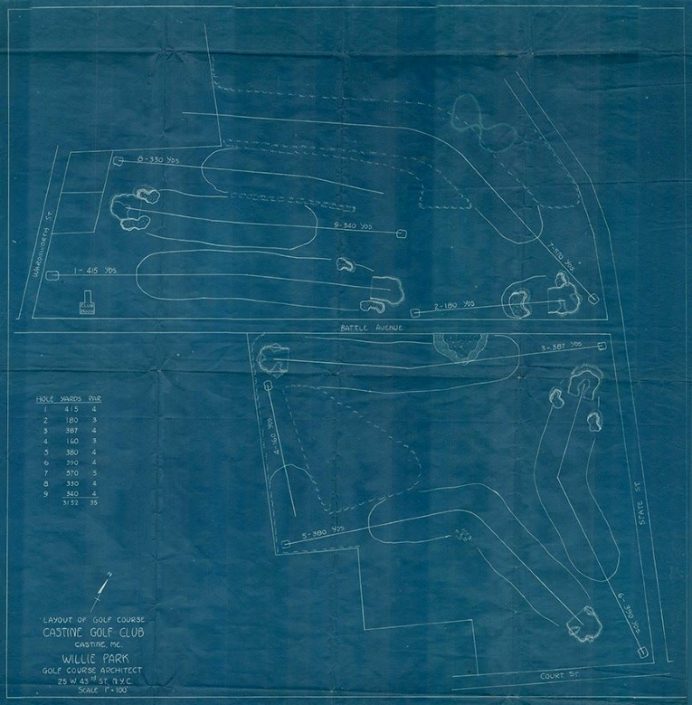
It is interesting to note the total lack of green sites on the drawing at #’s 4, 7 and 8.Also note the detail of the mounds that intrude into the 2nd, 3rd and 5th green surfaces. Today, the 6th green still retains Willie’s central thumbprint on what is the largest green on the course. The club is also considering recreating the straight line green fronts as depicted in the rendering.
Milton-Hoosic Club, Canton, MA: The Milton-Hoosic Club, founded in 1891, features an intact Willie Park, Jr. designed golf course dating to 1921. In 2014 the club hired architect Robert McNeil to develop a master plan for the restoration of MHC’s classic nine-hole track. Work began in 2015 with the recapturing of fairway widths and playing corridors. In following years, the club continued with locating and rebuilding multiple lost fairway bunkers, the full renovation of numerous greenside bunkers, as well as reclaiming original green contours with careful green expansions. Locating and building appropriate new teeing areas is ongoing. Poor growing environments and overgrown playing corridors were further corrected beginning in the winter of 2019 with an extensive tree removal project. Tree removal has not only begun to help correct agronomic issues around green sites, but dramatically re-established lost cross-course views and vistas. The grounds crew has worked diligently to create firm and fast conditioning from tee to green so to recapture many of the course’s original playing characteristics.
Saratoga Golf and Polo Club, Saratoga, NY: Dating from the earliest days of American golf the Saratoga Golf & Polo Club was just another old 9-hole course with classic architectural features that had been lost or covered up by tree planting, poor mowing lines, bland bunkers and general ignorance of the features that make such courses rare. Little-known Scottish professional R.C.B. Anderson is credited as the designer of the course in 1896. Current club member and golf historian David Normoyle uncovered descriptions of how the course played at the turn of the century and located aerials dating to the 1940s plus every decade thereafter that showed the development (or deterioration) of the course. For example, in 1948, when the mature course was already 50 years old, there were only 14 trees on the interior of the property and the naturally running fairways were 60 yards wide. By 2013, hundreds of cheaply planted trees had begun to choke soggy fairways that averaged a mere 27 yards.
Minimal in-house changes began in 2014 with fairway mowing lines being adjusted, initial tree removal and recognition that a full bunker project would be required. An overall campus (course, clubhouse and facilities) master plan was developed and in 2017 Kye Goalby became the man behind the execution of the golf course component of the club’s goals. New superintendent, Steven Aspinall, was hired from Morris County (Raynor) in NJ in late 2018 to assist Kye with bringing the vision to life. The success of the completed changes in combination with a new emphasis on lean, firm conditions, landed the course at #11 in GOLF Magazine’s 2020 inaugural ranking of the Top 50 9-hole courses in the world. Work still remains to be done on Goalby’s master plan and it will be interesting to see how the Victorian-era course continues to emerge.

Saratoga G&PC Map
Weekapaug GC, Westerly, RI: Another course off the Golf Magazine Top 50 9 hole ranking, Weekapaug GC, completed bunker renovation work in the fall of 2008. The project was done by architect Dave Zinkland and bunker guru Jeff Bradley, both with extensive experience working with Coore & Crenshaw. The club wanted to not only bring challenge and character to its seaside location, but make the course play more strategic on its wide-open, links-style layout. This work was not a restoration, but was important so as to reinforce the principle that bunkers are meant to be hazards and not just for aesthetics, although with this project, Weekapaug gets a standing ovation for accomplishing both.

Bunker work at Weekapaug’s #4
17. I can attest to how exceptional Saratoga Golf & Polo has become in just the past few years and it definitely serves as a road map for other 9 holers to consider in terms of doing proper due diligence and hiring talented people. Wrapping up, your annual pilgrimage to the UK was scuttled due to C-19 last year. Have you re-booked? What courses are on you most keen to see?
I still have not rebooked due to the questions that still swirl around golf travel to the UK. My 2021 trip is simply going to be a rebooking of the trip I didn’t take in 2020: Fly into Glasgow and drive north to Inverness, a week of self-catering in the Inverness area, plus 2 or 3 days on either side to explore the areas in between. I usually am there for 11 or 12 days. This trip has about a 50/50 split of 9’s and 18’s. I also try to play in a couple of opens to meet more locals. I usually contact secretaries in advance in hope of playing with a member at any course that I haven’t previously visited. I do not chase after rota courses and the most popular ones that most tour operators are selling but rather, I always do my own research to select the courses, old-world lodging and best pub meals. My trips usually end up costing about $2k including airfare.
Here are the courses for the Inverness trip:
| 9’s | 18’s |
| St. Fillans | Boat of Garten |
| Carrbridge | Kingussie |
| Covesea | Newtonmore |
| Bridge of Arran | Muir of Ord |
| Portmahomack | Moray (Old & New) |
| Comrie | Fortrose and Rosemarkie |
| St. Fillans (again) | Grantown-on-Spey |
| Pitlochry |
An exciting Northern Wales trip is also currently being planned with a 50/50 mix of 9’s and 18’s – some stunning golf there that doesn’t get its fair share of exposure. It is about a nine-day trip, flying in and out of Manchester.
18. First, I didn’t know you even played 18-holers and second, anything to do with Northern Wales will make my hero Richard Fisher very happy indeed. We look forward to a follow-up Feature Interview in a couple of years on your UK findings! Parting words of wisdom?
I will leave you with this feeling from Andrew Greig in “Preferred Lies” when he writes, “The true pilgrim wanders off to the outlying, the more humble and obscure courses. For it is on those unsung courses…that you may look around at your friends, the pulsing light on the grey sea, the undulating fairway, the club in your still singing hands and the distant green, and know yourself in earthly heaven.”










